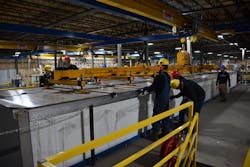The good news from the FTR Transportation Intelligence quarterly update is that the forecast has increased across the board for Class 8, trailers, and medium-duty trucks. But that improved forecast—delivered in a July 2 webinar, “The Long Climb Back”—comes with an asterisk, explained Don Ake, FTR vice president, commercial vehicles.
“[The adjustment] doesn't really reflect a view that things are better—it's more that we're better able to see where things are now, where things have stabilized,” Ake said. He pointed to the high levels of volatility and uncertainty in the forecasts from early spring, and noted the outlook was “still kind of hazy” in May and June.
By the numbers, FTR now forecasts the Class 8 build for 2020 to come in at 160,000 units (up from 152,000, or a 5% increase); US trailer production will reach 189,000 units (up from 163,000; 16%); and Class 4-7 builds will reach 165,400 units (up from 162,200; 2%).
The trailer market has been on a “roller coaster” in the first half of the year, Ake noted, and he pointed to April orders that fell into the hundreds after being more than 30,000 units as recently as last October.
“The trailer industry over last three months has gone through a lot of differences of opinion,” Ake said. “Some people thought that the forecast that we put out initially was too low. Then, a month later, when things got a little bit worse order-wise, they thought that that forecasts might be a little bit too high. Now things have stabilized some, and we're getting a better picture so we think the outlook going forward is a little better.”
Indeed, Ake suggested that FTR expects orders in June to be “good.” And while the FTR preliminary trailer order total for June has yet to be released, Ake added that “some reports from the field say that orders are so good that some suppliers are struggling to catch up with demand, which is great.”
Ake credited trailer OEMs with working around the sort of production stoppages truck and auto manufacturers have had to endure.
“The OEMs managed their production and their supply chain very well. I hope some college student does a case study on this, about how to manage your supply chain in a crisis—because they did it,” Ake said. “There were very few times that they were lacking parts in order to build trailers, so they were still able to produce at a decent rate through all the turmoil. They weren't as dependent, when you got into May, on the Mexico supply chain. They produced, under the circumstances, at a decent rate in April, and at a little bit better rate in May.
“So the forecast was adjusted up based off of two things: We had many more trailers built in Q2 than we expected; and then we're starting at a much higher base going forward. That boosted up Q3, and a little bit in Q4.”
By quarter, FTR projects 41,600 trailers will be built in Q2, followed by nearly 44,000 trailers in Q3 and Q4. Look for 2021 to begin with nearly 48,000 trailers in Q1 before climbing into the mid-50,000-unit level the rest of the year and to more than 60,000 per quarter in 2022. FTR projects factory trailer shipments will peak at 330,000 units in 2023 followed by a strong 310,000 units in 2024.
Class 8 cycle
Though he could not discuss the Class 8 net orders report prior to its release later on July 2, that preliminary result reflected a sharp rebound at 15,500 units, up 130-% from May.
“The great thing about the order improvement in June is that it should permit OEMs to continue to produce at a steady, but still reduced rate, for a couple of months,” Ake said in the report. “However, some of the OEMs need higher order volumes in July to keep the industry moving out of the mire caused by the virus.”
For the webinar, Ake focused on the Class 8 backlog, a “classic” symmetrical bell curve illustrating the cyclical nature of the industry. He also pointed out that when the Class 8 backlog reached low points in 2013, 2016 and 2017 (with 2013 and 2016 being even lower than current levels) orders quickly recovered.
“The problem with this analysis is that in the other three cases, that was at a typical truck cycle where you hit bottom, and after that you orders went up and you revived,” Ake said. “We do not expect those numbers off of this backlog and you see that in our forecast. The point here is that we can get that volume fairly easily starting with that backlog—if things get better.
“There's still too much uncertainty, but there is some upside potential and there is some upward movement.”
Looking ahead, FTR projects North American Class 8 factory shipments to come in at 23,500 for Q2 (down from about 60,000 in Q1 after running at about 90,000 for the first three quarters of 2019), and at about 38,000 for Q3 and Q4. Shipments will run about 50,000 per quarter in 2021 before climbing to about 70,000 per quarter in 2022. FTR forecasts Class 8 shipments to peak at 340,000 in 2023 and remain high at 300,000 in 2024.
“The other good news is that in the last upcycle we were constrained some by capacity, and the OEMs are adding some capacity,” Ake said. “So the OEMs are looking ahead, and they're trying to be better prepared for the upcycle, so we should not be as capacity constrained as we were.”
GDP rebound
According to the FTR outlook, GDP will finish the second quarter down 19.6% (a slight improvement from the previous estimate of a 22% decline), rebound with 12.4% increase in Q2 (a slight downward revision to the previous estimate of 13.9%), and close out the year with a 6.8% improvement in Q4 (compared to the previous estimate of 7.9%). FTR calls for GDP growth of about 4% throughout 2021.
“The swings here are so enormous that the changes in our forecast might appear less significant than they are,” Avery Vise, FTR vice president, trucking, said. “For example, our outlook for Q2 is improved by 2.4 percentage points. And while that may not sound like much, 2.4% is actually more than the annualized growth rate we've seen in any quarter since the early part of 2019.”
Still, the factors that drive GDP have been so “so volatile” that the potential for “significant changes” remains for the rest of the year. Vise also noted FTR’s forecast does not include any assumptions regarding a second wave of COVID-19 infections later in the year.
“We don't expect GDP to return to pre-crisis levels until the middle of next year—and that's just to get back to the actual level of output that we had in Q4 of last year,” Vise said. “That's not even taking into account what we would have seen, had we had the kind of modest growth we were expecting before the crisis. So we're still quite behind the curve.”
The outlook for industrial production, on the other hand, follows a different pattern: after being revised slightly downward for Q2 (from -36.6% to -39.8%), IP will make a huge quarter-to-quarter rebound, up nearly 25%, after FTR previously forecast a 1.3% slip. For Q4, the increase is expected to be 5.5% compared with the previous estimate of 7.1%. IP growth in 2021 will begin the year at nearly 10% before tapering off slightly throughout the year, according to FTR.
“We do not expect to return to the pre-crisis IP levels until late next year and maybe not even until 2022,” Vise said.
Trucking trends
A “bright” spot in the pandemic-crippled US economy has been recent activity in the freight spot market, Vise explained, with spot loads for the last week of June reaching the highest level since July 2018, according to truckstop.com data.
“The dry van segment quite clearly has seen the strongest recovery,” Vise said, noting a 17% bump from the previous week, making the number of spot loads 36% higher than the year before and 31% above the five-year average.
The refrigerated spot market also has surged recently, running 18% ahead of the same week in 2019 and 22% above the five-year average. Flat bed spot loads were 9% ahead of the same week the year before, and about 13% above the five-year average. (Flatbed, however, has struggled since the March slowdown, before which the segment had been running at two-year highs.)
“The spot market metrics are a useful tool, but they're just part of the freight picture,” Vise said. “One thing you have to keep in mind on the spot market is that it thrives on disruption. And we’ve had disruption in spades over the last three months.”
Still, even as FTR has seen “an incremental firming” of the freight markets in the successive forecasts, the outlook remains negative year-over-year, and the latest forecast is for a decline of 5.7% in 2020—still about a percentage point better than it was in the prior FTR outlook. For 2021, FTR calls for growth of about 6% from this year.
As with GDP and industrial production, “we don't expect volume to recover to pre-crisis levels in trucking until about the second half of next year,” Vise said.
About the Author
Kevin Jones
Editor
Kevin has served as editor-in-chief of Trailer/Body Builders magazine since 2017—just the third editor in the magazine’s 60 years. He is also editorial director for Endeavor Business Media’s Commercial Vehicle group, which includes FleetOwner, Bulk Transporter, Refrigerated Transporter, American Trucker, and Fleet Maintenance magazines and websites.
Working from Beaufort, S.C., Kevin has covered trucking and manufacturing for nearly 20 years. His writing and commentary about the trucking industry and, previously, business and government, has been recognized with numerous state, regional, and national journalism awards.

